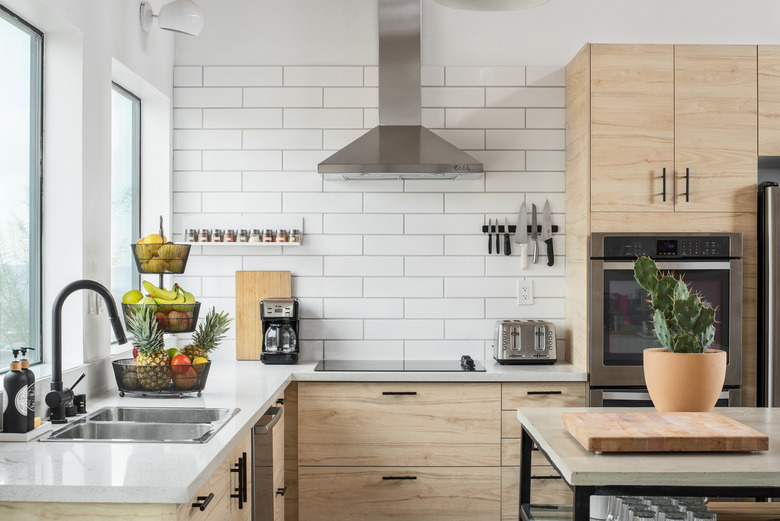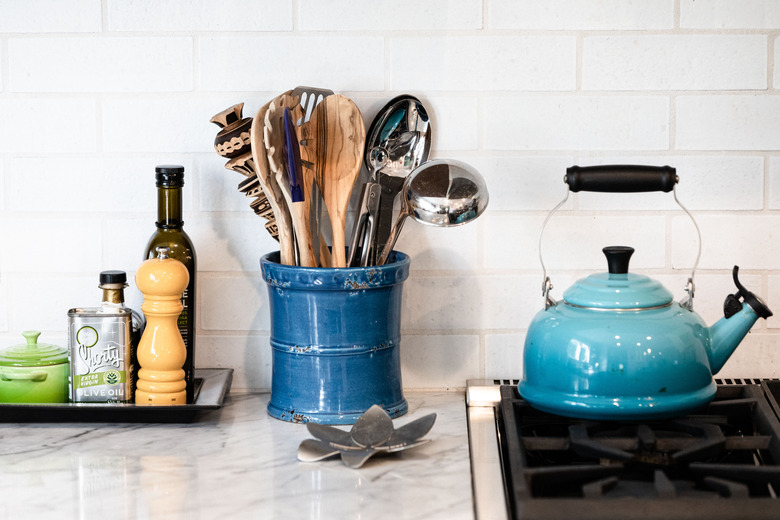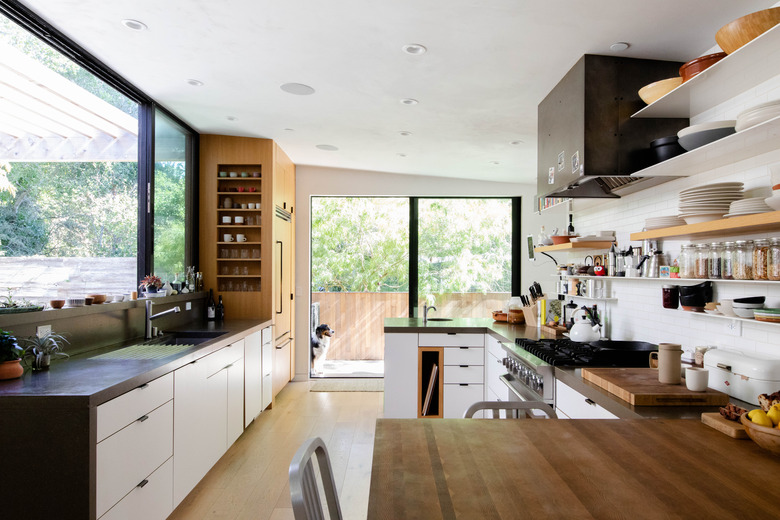What Are Paper Composite Countertops?
It's hip, it's affordable, it's environmentally friendly and it's durable. It's ... paper composite countertops? Paper countertops certainly don't sound very sturdy, but they're actually harder than wood and are quite durable. If you're in the market for new counters, paper composite is definitely worth considering once you know what the heck it is.
Tip
Durable and sturdy, composite paper countertops are made by compressing paper and resin. Most paper counters are made from recycled paper.
What Are Paper Composite Countertops?
What Are Paper Composite Countertops?
As their name suggests, paper composite countertops truly are made of paper. The manufacturing process starts by creating large sheets of paper. Some companies use post-consumer recycled paper to make their countertops. Others use paper made only of trees harvested from sustainable sources certified by the Forest Stewardship Council. Not every manufacturer does so, however, so ask about the content of a particular countertop if the environmental friendliness of the product concerns you.
Once the paper is acquired, the manufacturing process begins by soaking the sheets in a special resin along with natural pigments to add color. The soaked paper sheets get stacked together and then compressed under intense pressure and high heat to fuse them into a solid-surface countertop.
The finished countertops look much like stone but are softer and warmer to the touch. Originally developed for use in science laboratories, industrial kitchens, fabrication shops and skateboard parks, paper-composite surfaces may feel softer than stone, but they're just as durable.
Pros and Cons of Paper Composite
Pros and Cons of Paper Composite
Paper-composite countertops provide a nonporous work surface, so you won't have to worry about spills seeping into the counter and causing a stain. You can also rest assured that germs and bacteria won't make their way into the counter either. Lighter than stone, paper composite counters are much easier to work with and allow for DIY countertop installation. Whether you do it yourself or hire a pro, hiding the seams in a paper countertop is much easier than doing so with other materials.
Although it's versatile enough to use outdoors as well as inside, there are a few things paper composite counters can't do, such as resist heat. According to Remodelista, paper composite counters aren't heat-resistant above 350 degrees Fahrenheit, so you'll need to use trivets or pot holders under hot cookware to avoid damaging your counter. Note too that despite being made from recycled materials, paper composite countertops themselves aren't recyclable because of the resin in them.
Paper composite also limits your color choices. The resin used to make these countertops is dark, so this particular material isn't available in light hues. There are several dark colors from which you can choose, but you won't find white or light-tan finishes. Things will get darker over time, as paper composite slowly darkens when exposed to UV light. If a changing patina will bother you, consider choosing a different countertop material.
Cost and Options
Cost and Options
According to HomeAdvisor, the average cost of paper composite countertops in 2020 is $40 to $70 per square foot. Professional installation increases the cost to $55 to $100 per square foot. Paper composite is easy to work with, however, so professional labor and installation costs are easy to avoid if you're on a budget and willing to choose PaperStone products.
When it comes to paper composite countertops, you basically have two products from which to choose: PaperStone and Richlite. These are the big names in paper composite, and both are quite similar. Both brands are made in the U.S., offer countertops made from 100-percent recycled paper and have eco-friendly-certified products. Richlite offers a much longer lifetime warranty on its countertops but only if they're professionally installed by a certified installer.
PaperStone is actually the brand name of a product manufactured by a company known as Klip Tech Bio Composites. Like Richlite, PaperStone is sold through a series of authorized dealers and isn't available at retail chains like Lowe's and Home Depot. PaperStone comes with a shorter 10-year warranty, but this warranty isn't automatically voided if you choose to install the countertop yourself. The manufacturer also makes sure that the resins used in the countertops are petroleum-free, making PaperStone a bit more environmentally friendly than Richlite.
DIY Friendly Installation
DIY Friendly Installation
Unlike many other countertop materials, paper composite is lightweight and easily cut with standard woodworking tools. Installing your new countertop is a fairly simple DIY project for those with basic carpentry skills, but remember that doing so may void your warranty if you purchased a Richlite product.
If you've weighed the risks and are ready to tackle the project, begin by carefully measuring your space and creating an accurate template of your existing countertop. You will then transfer the template to your new countertop, easily cutting holes for sinks, stovetops and other fixtures using a router with a carbide bit.
When you're finished cutting your counter, install it using a two-part epoxy. Paper composite countertops will work with undermount sinks, so you can install one by mounting the sink to the underside of the counter before flipping the counter right-side up and installing it. Drop-in cooktops and self-rimming sinks are installed after the countertop is in place.
After the installation, it's time to pick your finish. If left alone, your new counter will have a nice matte finish that hides dust and fingerprints. You may opt to sand the countertop, however. Doing so will create a more mottled color pattern and a slightly glossier finish. It will also make it necessary to seal the countertop more often, so choose carefully.
Care and Maintenance
Care and Maintenance
To keep your new counter looking its best, simply wipe up spills and messes with a damp cloth. Avoid using alkaline soaps like dish soap on the counter, as these can dull the surface over time. When first installing the countertops and once a year thereafter, seal the surface with food-safe mineral oil. Doing so will help prevent fingerprints and other grease spots from marring the finish.
Your new paper composite countertop is tough, but it's not indestructible. Always use trivets under hot cookware and cut foods on a cutting board rather than the countertop itself. If your counter does develop scratches or stains, you can sand them away with an abrasive pad. The color goes through your entire countertop, so you need not worry that an occasional sanding will remove the color.
References
- Remodelista: Remodeling 101: Paper Composite Countertops for the Kitchen
- HomeAdvisor: How Much Does It Cost To Install Or Replace Countertops?
- Green Home Solutions: PaperStone – The Unique Countertop That's Both Sustainable and Affordable
- Green Home Solutions: Fabrication and Finish Guide
- Stock Cabinet Express: The Pros & Cons of Composite Paper Countertops
- Home Style Choices: Composite And Recycled Countertops


